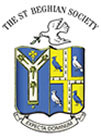|
 |
The Old St Beghian | |
| July 2019 | |||
Reminiscences from Dorothy Shackley:
Dorothy (Dot) Shackley was 14 when she reluctantly left school to work at St Bees public school for 12 shillings and 6 pence a week (52.5p). The eldest of nine children, she was required to work. In the summer of 1947 she remembers walking to St Bees School in a new blue dress and white ankle socks. Jean McAllister, a colleague, sat her on her knee and said, ‘tha’s ganna be a la’l killer’. That is of course Cumbrian for ‘you’re beautiful’!
Mary Waring was the secretary of Mr Reekie, the Headmaster; she also ran the Girl Guides in the village and got Dorothy the job at the school. Dorothy worked and lived in School House as did the Headmaster and his family. The head and his wife had three children: Andrew, Jane and Susan, who were around eight, four and two respectively. Dorothy remembers them fondly.
Although Dorothy lived in the village, she was allocated a bedroom at school. She was pleased with the room, but being able to run a bath in her bathroom was a delight. (At home she used a tin bath in front of the fire!)
She worked from early in the morning until late in the evening with two hours off in the afternoon and had varied domestic duties, from cleaning the Headmaster’s accommodation to waiting on the boys in the dining room. Going into the dining room was daunting, although on her first day she was happy to receive her first compliment when an older boy at the top table said she had a nice figure! The boys on the bottom table were around her age, as she collected their plates they would tease her and pull them back.
Two Danish girls named Analisa and Kirsten came to work at the school. They were opposites in character. Analisa cried before she had to go in the dining room, she said, ‘I’ve got the inferiority complex’. Kirsten on the other hand enjoyed distracting the boys. In the evening, from the dining room window, she could see some of the boys doing their prep. She would dance and ask them if they liked her skirt. Dorothy remembers one boy with whom she was friends and who was a real gentleman. After she had lost her gloves, he found them and returned them to the kitchen the following day. Mrs Breton, who was in charge there, laughingly said, ‘your gloves, madam’ as she handed them back.
A painting of Dorothy by John Dalzell Kenworthy (1858-1954), painted in 1944 when she was 12.
Mr Kenworthy, as well as being a celebrated painter, was a village resident.
In 1949 Dorothy’s sister, Martha, started work as a private maid to the housemaster, Mr Parkinson. He was a very nice calm man but was always looking for Martha as she was easy-going and not at all conscientious. When she took him a breakfast tray there was usually something missing. For example, quite often there was water but no tea in the teapot!Lily, another sister, worked in Mrs Hale’s tuck shop and also in Mrs Lamb’s wool/baby clothes shop at the bottom of Outrigg hill. The boys often needed to buy wool!
Dorothy’s best friend was June Parker, who lived in the village. When one of the boys in particular on Grindal had the duty to play the 10pm bugle roll call, he would, it was said, play it especially for June.
Dorothy worked at the school for three years; she remembers it as a happy time working for nice people. She worked hard but had fun and made friends.
Home
The St Beghian Society
St Bees School,
St Bees, Cumbria, CA27 0DS.
Tel: (01946) 828093 Email: osb@stbeesschool.co.uk
Web: www.st-beghian-society.co.uk
![]()
 painted in 1944 when she was 12.jpg)